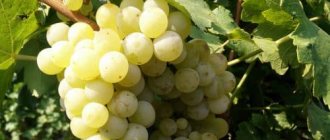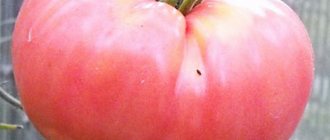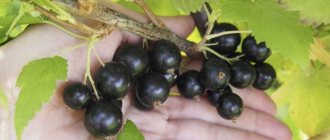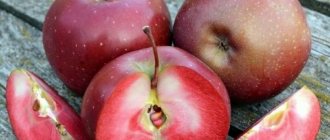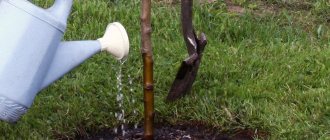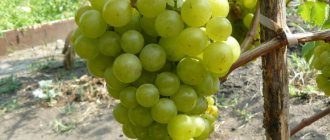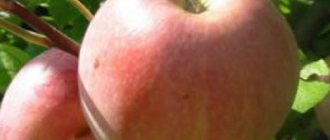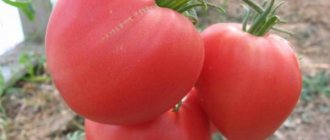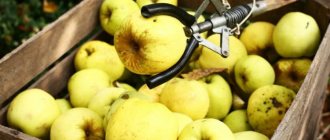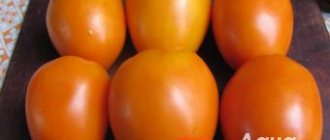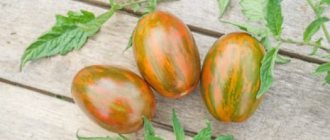Description
The plant is medium-sized - about 4.5 - 4.8 meters, but if pruning is not done on time, the tree can grow above five meters. In the first three years after planting, the growth is about 80 cm, then the annual growth is limited to 50 cm. Annual shoots are light, brown-green. The lentils are small, light-colored, and not densely located on the surface of the bark. The leaves of Pink Pearl are medium in size, elongated-ovate in shape, with a rounded wedge-shaped base, green in color, the venation is weakly expressed. The edges of the plate, covered with serrated serrations, are raised towards the center, the slightly elongated apex is bent downwards. The surface of the leaf is pubescent, the reverse side has a lighter shade and slight pubescence. The petiole is of medium length or long, not thick, not colored. Stipules subulate. During the flowering season, the apple tree looks fantastically attractive due to its abundant flowering. The flowers of the variety are bright, pink, five-petaled, saucer-shaped. The petals have a rounded top. Sepals are light, pubescent. The inflorescence has about 5 flowers. The buds are elongated, with a pointed tip, growing, clinging to the shoot. Fruiting occurs on the ringlets and tops of one-year-old shoots.
The most suitable rootstock for Pink Pearl is MM-111 (medium or vigorous). It is quite frost-resistant and resistant to major diseases. It is convenient to regulate the growth force of the grafted variety.
The fruits of the apple tree are oblong-conical in shape, sometimes with weakly expressed wide ribbing and a slightly beveled top. Medium size, weight about 180 grams. But apples can be quite small - about 70 grams, or, on the contrary, large - up to 350 grams. The funnel is narrow and deep, with traces of rust. The stalk is not long, of medium thickness. The saucer is shallow, of medium width, with a pleat. The calyx is half open. The subcalyx tube is medium wide, long, and connects to the seed socket. The seed nests are small, oblong, the heart is wide. The skin is shiny, thin and tender. The main color of the fruit of this variety is very modest, usually light green, sometimes yellowish, and often creates the illusion that the skin is translucent. The covering may appear as a slight blurred blush of light crimson color. Subcutaneous dots are light, clearly visible, cover the surface quite densely, the greatest localization is near the apex.
The fruits of Pink Pearls are full of surprises for those who are just trying these amazing apples for the first time. Under the unremarkable skin lies a pulp of unusual color and taste. It is painted in a bright crimson color. The structure is quite dense, crispy, fine-grained, very juicy and aromatic. But not only the color of the pulp is surprising, but also the taste. The taste qualities, perhaps, cannot be described unambiguously. The taste is sweet and sour, with tartness, with notes of grapefruit and raspberries. But as American gardeners write, the texture of the pulp, the intensity of its color and taste largely depend on the degree of ripening and seasonal conditions. The red pulp contains large amounts of vitamins A, C and B, pectin and very few calories. This is why this apple tree is so popular in dietary nutrition, especially for lowering cholesterol levels.
Here is how one of the American gardeners, who has been growing this variety for quite a long time, rated the fruits of Pink Pearl on a 10-point scale:
- apple taste - 7;
- crunch of pulp - 7;
- astringency - 7;
- juiciness - 5;
- sweetness - 5.
Planting and care
Pink pearls are planted in autumn and spring. The plant is not very picky about soils; there was information that the plant bore fruit even on clay soils. But it is still better to select sunny places for planting with well-permeable and nutritious soil. Loams meet these requirements. The distance between neighboring plants should be about 4 meters. Good companions for the variety will be Californian jockstrap, alder and gooseberry. It is best to prune an apple tree at the very beginning of spring, before sap flow begins. The main goal of the procedure is to eliminate the thickening of the crown by removing the branches growing inward, and the side shoots are shortened by 1/3. Up to 50 liters of water are poured under an adult plant once a month. But weather conditions should be taken into account, for example, if the weather is hot and no precipitation is expected, then the frequency of watering can be increased; in rainy weather, on the contrary, it can be reduced, as well as the amount of water. In the spring, nitroammophoska can be used as a top dressing; during the flowering period, wood ash rich in microelements can be used; in the fall, phosphorus-potassium fertilizers can be used.
Pink pearl is a rather interesting plant. In spring it decorates the garden with bright blooms, and in early autumn it gives the gardener amazing fruits full of surprises. Caring for the variety is not at all difficult, the main thing is to choose the right place for planting, and then simply carry out the agricultural techniques characteristic of the crop. The main value of the variety is the unusual color and taste of the pulp. Indeed, in our garden there are practically no apple trees with red fruits, so for many this variety will no doubt be very interesting. Moreover, you can eat apples not only in their natural form. Due to the fact that the pulp goes well with many products, the hostess will be able to surprise her family and guests with exquisite gourmet dishes. The disadvantages of the culture are self-sterility and frequency of fruiting. But these shortcomings can be easily tolerated, given the exotic nature of the overseas guest.
An unusual apple variety, Pink Pearl, bred by breeders, has a special taste and unusual appearance. The bright pulp of the fruit attracts the eye and encourages you to choose this particular variety for planting.
More than half a century ago, the Pink Pearl apple variety was bred by breeder Albert Ethier. This fruit is very popular in the USA; it also grows and bears fruit well in Russia. If it is difficult to find seedlings of this apple variety on the market, you can easily order them from a nursery and receive them by parcel.
History of the variety's creation
In the creation of all varieties of apples with red flesh, a descendant of the Niedzwiecki apple tree, the red-fleshed variety Surprise, was used. The Nedzvetsky apple tree comes from Dagestan, where it grows wild. It is also widespread in China. In gardening, the Niedzwiecki apple tree is used not as a fruit tree, but as an ornamental plant with unusual leaf color. It is especially beautiful at the time of flowering, all strewn with bright pink flowers. The fruits of this apple tree, although small, are quite edible; they are used to make jam and compotes.
The Pink Pearl apple tree was created in California more than 50 years ago by US breeder Albert Etter. He spent almost 25 years on the selection process, patented the created variety, and then gave it to The California Nursery Company for propagation. A year later, the apple variety was presented in catalogs of fruit crops and quickly spread throughout the country. This productive and unpretentious tree is most often grown in the states of Oregon, California and Washington.
The unusual reddish-pink color of the apple pulp prompted the creator of the variety to give it the original name - Pink Pearl, since due to some heterogeneity in color, the apple pulp acquired a shimmering effect. The Pink Pearl variety appeared on the Russian market quite recently, so this variety is not widespread.
To be fair, it must be said that Albert Etter was not the first to develop red-fleshed apple varieties. The outstanding Russian breeder Ivan Vladimirovich Michurin did this and succeeded well in this. The goal of his work in this area was to increase the frost resistance of apple trees, and the production of red-fleshed apple varieties turned out to be a side effect.
The varieties he bred: Bellefleur red, Yakhontovoye, Red Standard, Komsomolets, Bellefleur record were distinguished not only by their decorative properties, but also by the good taste of the fruits. And the Bellefleur red variety is still the standard among apple varieties with red flesh.
Among modern varieties of apple trees with fruits that have red flesh, the Pink Pearl apple variety stands out, which has collected many positive reviews. Let's get to know him better. To do this, we will give the Pink Pearl variety a full description and description, but first we will look at the photo.
Golden
PROS:
- The type of fruiting is characterized as mixed
- The harvest is regular
- Apples reach medium and large sizes, up to 170 g
- The structure of the pulp is soft, juicy, and has a dessert taste.
- Collection can be done in September
- Increased winter hardiness, productivity
- The taste characteristics are excellent
- Fruits are not afraid of transportation over long distances
- They have sufficient shelf life, up to three months
- Early fruiting period, for 3 years
MINUSES:
- The need for careful and high-quality pruning
- There is a need for fruit thinning
- Their tendency to wither
- Self-sterility, requiring additional pollination
- Recommended pollinators: Wagner's Prize, Jonathan, Delicious Spur, Kuban
- Poor resistance to powdery mildew
It is popular among gardeners; it is chosen because of its ability to withstand severe frosts, excellent consumer qualities and early fruiting period.
Growing garden blackberries - a description from purchasing a seedling and planting it in open ground to caring for and harvesting from the Moscow region to Siberia (Photo & Video) + Reviews
Diseases and pests
The Aromatnoye apple tree variety is highly resistant to various diseases. The tree is also considered resistant to scab. But cases of the disease are common
It is important to carry out ongoing prevention
Highly resistant to scab are: Daughter of Pepinchik, Zhigulevskoe, Bogatyr, Berkutovskoe and Aphrodite.
To avoid damage, it is important to isolate the apple tree from other crops in the garden, carefully monitor the plant and constantly disinfect and fertilize the soil. The peculiarity of scab is that first of all it affects the leaves of the tree, and then moves to the fruits
The trunk remains completely healthy
The peculiarity of scab is that first of all it affects the leaves of the tree, and then moves to the fruits. The trunk remains completely healthy.
The cause of the appearance of this fungus may be stagnation of air inside the tree crown or high humidity.
The first signs of scab are the appearance of green-brown spots on the leaves, as well as a large number of small brown, crust-forming spots on the fruit.
To prevent this disease, it is important to carry out prevention, which consists of:
- adding ash to the soil;
- crown formation;
- replenishment with potash fertilizers;
- feeding with compost.
If the disease does affect the tree, it is necessary to immediately begin treatment. Treatment occurs by cultivating the soil around the crop and spraying the tree with various mixtures.
As a rule, this is a universal set of measures, which is the prevention and treatment of almost all diseases of the garden tree.
The best means for treatment are: urea solution (on average 7-8 liters per tree), copper oxychloride, which must be used first before flowering, and then during the appearance of the first fruits, and Bordeaux mixture, which can easily be replaced with copper sulfate .
Most often, trees of the Aromatnoye variety are affected by tinder fungus.
It severely affects the trunk of the apple tree, but affects the fruit indirectly. Such a fungus must be eliminated immediately.
The daily presence of the fungus on the bark draws out a lot of strength and nutrients that the apple tree needs for normal existence.
If this is not done, the defeat process can be considered irreversible.
If the mushroom has not yet become too hard, you can use a regular garden knife to cut it off. If the mushroom has severely damaged the tree and has become very large and quite hard, you will have to use an ax.
Naturally, healthy wood will also suffer.
It is important to destroy the fungus at its very roots. Otherwise, after some time, the mushroom will “settle” again in the same place
After removing the infection, the place where it grew must be disinfected. The main thing is that the cut is even; most often it is possible to make a couple more cuts.
The treatment should be carried out with copper sulfate, after which it is advisable to paint over the treated area with oil paint. If this is not done, the wound will soon become a nest for various types of pests.
Among pests, special attention should be paid to the prevention of the appearance of codling moth, fruit sapwood, silkworms, hawthorn and leafminer moths. The Aromatnoye apple tree is considered one of the most unpretentious and undemanding varieties to grow and care for.
A big advantage is the self-fertility of the variety. The fruits have excellent organoleptic properties and will appeal to lovers of freshly squeezed homemade juices.
The Aromatnoye apple tree is considered one of the most unpretentious and undemanding varieties to grow and care for. A big advantage is the self-fertility of the variety. The fruits have excellent organoleptic properties and will appeal to lovers of freshly squeezed homemade juices.
Description
The authors are breeders from VNIIS named after. Michurina.
By crossing "Welsie" and "Signe Tilline", this wonderful summer hybrid was obtained.
Recommendation! The hybrid is zoned in the Tambov region. Accordingly, the best place for cultivation is considered to be the Central Black Earth region.
The tree grows small, which makes caring for the apple tree easy.
The crown is round, even slightly flattened, not thickened, but leafy.
The fruits are one-dimensional, reaching 180 g.
The color is golden yellow with a slight blush and a rusty funnel.
The apples are round and broadly ribbed.
Characteristics and description of the “Legend” apple tree
The tree is medium-sized, reaching 2.5-3 meters in height. The crown is neat, not spreading, dense, and acquires a rounded shape. The leaves are ovoid, medium in size, the surface of the plates is smooth and shiny, colored emerald. The shoots and trunk are painted gray with a brown tint.
The fruits are oval-conical, large, the skin is yellow-green with a red blush over the entire surface of the apples. The pulp is white with a slight green-yellow tint, fine-grained, dense, caramel-like taste, with a wonderful rich apple aroma. On average, the weight reaches 170-200 grams. The “Legend” variety stands out for its high yield; 90-100 kilograms of fruit can be collected from one mature tree. The plant exhibits high resistance to frost. The tree resists scab and other bacterial and fungal diseases. The apple tree has average drought resistance.
It differs from other varieties in its precociousness; it begins to bear fruit in the second year after planting on the site. At 5-7 years, the tree begins to bear fruit in full force, from this moment maximum yields can be collected. The fruits ripen by October. They are stored for 3-4 months, then they begin to rot. Suitable for fresh consumption and any type of processing: preparing compotes, drying, preparing desserts, juices, preserves, jams, etc. It can be grown in central Russia, the South, even in Siberia and the Urals.
Advantages and disadvantages of the Legend variety
The apple tree began to gain popularity among gardeners from the moment it was entered into the state register. The main advantages include:
- high level of frost resistance;
- The apple tree is unpretentious in care;
- resistant to bacterial and fungal diseases;
- excellent taste of the fruit;
- large-fruited.
The disadvantage is the irregularity of yield, which can be either very high or low.
Reviews from gardeners
Every gardener who has ever encountered this variety has been delighted with it. He is absolutely unpretentious in care. It produces a magnificent harvest and pleases with its delicious fruits.
In the south the tree grows and flourishes. Given its high frost resistance, the Pink Pearl apple tree is also grown in the Urals, in the North and West of Russia.
Apples are distinguished not only by their unusual appearance, but also by their rich palette of taste. The beneficial properties of the fruit are also noted. This is an elite variety that has absorbed excellent taste, beauty and ease of care.
Description of the variety Aromatic
The appearance of the apple tree is characterized by medium height, a dense bright green crown and light yellow-pink fruits.
They grow very quickly, have a round, stack-shaped, compact crown of medium density, not tall (on average 2-4 m).
The branches are located close to each other, but do not intertwine.
The leaves are bright green, slightly curved. The bark is dark brown-gray.
Flowering period is late (second ten days of May). The shoots are roundish with a brown tint.
The fruits ripen at the end of September and are stored until February. Apples are considered large. On average 160-220 grams. The fruits are smooth, ovoid or flat-round.
Color – golden yellow with a brown tint. The aromatic apple has a sweet and sour dessert taste. The pulp is not dense in consistency, white, with a pleasant sweet and sour taste and spicy aroma.
The following apple varieties can also please you with excellent taste: Orlik, Aport, Orlovsky Pioneer, Ekranny and Orlinka.
Description, photo
Pink pearls are a natural semi-dwarf , early- fruiting variety with late summer ripening.
Advantages of the variety:
- High winter hardiness;
- Unusual color and taste of fruits;
- High content of vitamin C.
Apple tree Pink pearl.
Disadvantage of the variety: poor resistance to scab.
In temperate climate zones, flowering begins in mid-May.
Harvesting begins in the second half of August and continues until mid-September.
Fruiting is periodic , apples have a shelf life of 4 weeks.
The fruits contain many vitamins, iron, and fiber.
Tasting taste rating: average . The fruits are used in their natural form, in cooking, baking, and also in the form of juice.
How and when to plant
When starting planting activities, you must first choose high-quality planting material. It is best to buy seedlings from a nursery that has a good reputation. The fact is that the variety has not yet become so widely known, so when buying a seedling on the market, you can grow a tree that does not correspond to the varietal characteristics.
It is worth purchasing a plant at 1-2 years of age. It is best to choose an option with a closed root system in a container or with an earthen ball. If the assortment contains plants only with an open root system, then make sure that it is well developed. Its length should not be less than 30 cm, and the shoot thickness should be 1.5-2.5 cm.
On the video - how to plant an apple tree:
Selection of location and soil
To plant an apple tree of the variety in question (and such as the Spartan apple tree), you should choose an area with good lighting
In this case, pay attention to the level of groundwater. It is best that they do not lie closer than 2-2.5 m
To plant Pink Pearls, you need to choose a bed with loamy and sandy loam soil, but the acidity will be neutral.
It can also be planted on slightly acidic soil. If the soil is clayey and heavy, as well as light sandy, then site preparation must be done in advance. It is best to plant Pink Pearl seedlings in the spring. If the plant was purchased in the fall, then it should be buried and stored in this form until spring.
When the soil begins to thaw to the required depth in the spring, you can make a planting hole for the seedling. Its depth should be at least 0.6 m, and its width should be 0.9-1.2 m. Place about 10 kg of fertilizer into the recess. Install the seedling and carefully straighten the root system. Make sure that the tips of the roots do not point upward.
Sprinkle the roots with soil, tamping it lightly. As soon as the root system is completely under the soil layer, it should be compacted thoroughly. To water the seedling, 20 liters of water are used. The peat mulch layer still needs to be laid.
When planting a plant, it is necessary that the root collar is concentrated 5 cm above the ground level. After planting, trim it. If there are no branches on the shoot, cut it off by 1/3.
Selection of seedlings
Since the variety is considered rare in Russia, it is necessary to purchase seedlings from trusted nurseries with a good reputation.
It is better to plant planting material with an open root system in the fall.
By purchasing a tree from unscrupulous sellers, you can get a harvest of fruits that do not meet the declared characteristics. The optimal age of the seedling is 1–2 years . It is advisable that the seedling be sold with a closed root system or a significant earthen lump on the roots.
If the tree has a visible root system, it is necessary to carefully inspect it before purchasing. The length of the roots should be more than 30 cm, the diameter of the trunk at the bottom should be up to 2.5 cm.
Apple tree care
A variety of apples with pink flesh, Pink pearls require more careful care in the first years of their development.
Top dressing
In the first year, for the full development of the seedling, the fertilizers applied during planting are sufficient. In subsequent years, the apple tree needs to be fed with organic and mineral fertilizers:
Soils depleted over the winter do not provide the nutrition necessary for a fruit tree.
In the spring, it is especially important to apply nitrogen fertilizers during the swelling phase of the buds. They are brought into the root circle, having previously dug the soil to a depth of 10 cm. For spring feeding, the following are suitable:
Suitable for spring feeding:
- urea (500 g), diluted in water (50 l);
- solution of manure and water 1: 8;
- bird droppings diluted in water 1:15.
Consumption per apple tree is 15 liters.
The second feeding is done in the phase of setting the first fruits with sodium fertilizers. To do this, you need to dilute 1 kg of nitrophoska and 20 g of sodium humate in 200 liters of water. The resulting nutrient solution is poured into the area around the trunk, using 3 buckets for each apple tree.
For young trees that have not yet bear fruit, autumn feeding with phosphorus and potassium fertilizers is important. They are added to moist soil during digging or diluted in 2 tbsp. l. in 10 liters of water and spill the soil around the trunk, using 2 buckets per apple tree.
Watering
Young apple trees need frequent watering, at least 4 times per season. Water is evenly distributed on the soil in the tree trunk area.
Water holes formed around the apple tree with a depth of 10-15 cm will help avoid unwanted exposure of the roots during watering
It is important that the moisture reaches the depth of the active roots; for the Pink Pearl apple tree this is 60-70 cm
Depending on the age of the tree, it needs different volumes of water:
- annual seedlings 2-3 buckets;
- two-year-old apple trees 4-5 buckets;
- three-year-old or more trees, at least 5-8 buckets.
The timing of watering depends entirely on climatic conditions. The first moistening is carried out before the buds open. If hot and dry weather sets in, trees under five years old should be watered at least once every two weeks. For mature trees, the second irrigation is carried out after the flowering phase, during the period of mass fruit set.
During prolonged dry weather, apple trees of the Pink Pearl variety should be watered during the fruit growth phase. Lack of moisture can lead to apples being crushed and actively dropping before ripening.
The last watering is carried out during the ripening period of apples, 2 weeks before harvesting. You should not irrigate during fruit harvesting and after that, as this can lead to active development of young shoots and weakening of the tree before the winter period.
Trimming
A properly formed crown of apple trees is the key to the quality of the fruit and the quantity of the harvest. Trees of the Pink Pearl apple tree varieties begin to be pruned in the first year after planting. The optimal time for pruning is the dormant period of the seedling.
To do this, choose late autumn, it is important that the air temperature is at least -10°C. Pruning during severe frosts makes the apple tree fragile and vulnerable to disease. When pruning, shoots are removed at the base and part of the fruiting branch is shortened
When pruning, shoots are removed at the base and part of the fruit-bearing branch is shortened.
Deformed, dried and frozen branches are removed. Apple trees are pruned every year, avoiding excessive development of the side branches and top of the tree.
Preparing for winter
Lime mortar is used to whitewash the lower part of the apple tree trunk. This will protect the tree from the appearance of frost holes during temperature changes, which cause the formation of rot. The lime layer will prevent possible sunburn in winter and spring and protect against rodents.
Adding insecticides to the solution is a good prevention against pests that remain overwintering in the bark. Young apple trees are whitened without preparation, and dead bark, lichens and moss are removed from mature trees. The best time for whitewashing is the third decade of autumn, when heavy rains stop and a stable sub-zero temperature sets in.
Insulation with a layer of mulch will prevent the tree roots from freezing. To do this, hill up the trunk circle to a height of 30-40 cm, and apply a layer of peat 5 cm. To avoid breakage of the side branches under the weight of snow, they are tied to the trunk.
Features of care
Caring for a young tree includes regular irrigation (Pink pearls will not tolerate drought well, especially in the first years), adding nutrients, pruning, preventing diseases and pest damage.
Watering
Watering the apple tree is carried out once a week, depending on weather conditions and the degree of drying of the soil. During dry periods, lack of moisture will negatively affect the yield and quality of fruits. On average, an adult tree needs up to 50 liters of water. By checking the depth of moisture (up to 60 cm), you can determine the sufficiency of watering.
Find out also how to make an apple tree bloom and bear fruit.
Rules for pruning and crown formation
To make it easier to process the apple tree, further care and harvest without additional funds, pruning and the formation of a wide and rounded crown are necessary.
The first pruning is done immediately after planting. An annual seedling should be pruned and left at a height of 60–90 cm from the ground level (usually a third of the height). For a two-year-old tree, you need to shorten the upper branches by 2/3, and the lower branches by 1/3, leaving at least three living buds. In the first years, the crown of the planted apple tree is formed; in the future, only sanitary pruning can be performed.
During the growth and development of the seedling up to 5–7 years, pruning to form the crown is aimed at creating a shape and thinning the trunk and skeletal branches from excess young growth. By this age, the tree should have 5–6 lower skeletal branches. Typically, a semi-dwarf rootstock is used for the Pink Pearl apple tree, so the height of the tree is limited to 4 m, and the height of the trunk is 60–70 cm.
Important! Any pruning should be carried out in the absence of sap flow: in early spring or after leaf fall in autumn
.
Pruning, in which problem and damaged branches are removed, is called sanitary pruning and is carried out after winter. Rejuvenating pruning is applied to old branches in order to obtain new shoots capable of laying fruit buds and ensuring fruiting.
Sanitary and anti-aging pruning eliminates shading of the inner part of the crown and thins out its density. At the same time, internal and intersecting branches are removed, side shoots are shortened by a third of the length.
Proper pruning will ensure sunlight, air flow and insect access to flowers for pollination. But this requires a proportionate and sensible approach, as excessive and aggressive pruning can weaken the tree and damage the crop.
Fertilizers and rates of their application
For the first 3 years, the apple tree does not need to be fed if the soil was fertilized when planting.
In the future, you can adhere to the following scheme for applying nutrients and foliar feeding:
- in early spring - organic and complex mineral fertilizers (rotted humus, compost, urea, nitroammophosphate, superphosphate);
- from the phase of ovary formation to the phase of fruit ripening - phosphorus-potassium, nitrogen is excluded from the composition of fertilizers, which contribute to the growth of green mass to the detriment of fruit formation;
- in the fall before winter - organic matter and wood ash rich in minerals, phosphorus-potassium fertilizers when digging tree trunk circles to a depth of 30 cm;
- If necessary, foliar fertilizing with minerals is carried out by spraying the foliage of the tree.
Important! When cleaning the trunk and branches, it is advisable to use plastic tools so as not to damage the healthy part of the trunk. Damage must be covered with garden varnish or paint.
Timely application of potassium and phosphorus fertilizers increases the yield and quality of fruits. Fertilizer application can be combined with regular watering.
Some gardeners recommend applying fertilizer directly to the snow in the tree trunk circles. This technique will ensure that during melting, a rapid and uniform supply of nutrients along with melt water to the roots of the tree.
Preparing for winter
The Pink Pearl apple tree is frost-resistant and, according to gardeners, can survive the winter cold without shelter. But depending on the growing region, where frosty and long winters with strong winds can cause irreparable damage to the apple tree.
Protecting a tree for the winter is one of the most important measures:
- before the first frost, the apple tree is well watered to prevent drying and freezing of the wood, and fed with potassium-phosphorus fertilizers to increase cold resistance;
- carry out preventive spraying of the soil around the tree trunks, trunk and branches with insecticides, choosing a sunny and windless day;
- autumn pruning is carried out a month before the onset of frost, so that the cuts have time to tighten;
- the root system is protected from frost and the formation of ice crust with the help of a 10 cm layer of mulch (leaves, straw, peat, spruce branches, sawdust are suitable for these purposes, and after a snowfall - a layer of snow);
- young seedlings are tied to a support for protection from the wind;
- To protect against freezing and rodents, trunks are wrapped with covering material (roofing felt, polyethylene, woven material, agrofibre), but when warm days arrive, the covering must be removed to avoid overheating.
In the fall, it is necessary to whiten the trunk and lower skeletal branches (by a third or half of the length) with a solution of lime with the addition of copper or iron sulfate.
This will protect the tree from rodents in winter, and in February, during the period of solar activity, it will protect the trunk and branches from ultraviolet burns.
In spring, whitewash should be renewed to protect against pests and fungal diseases. If you plan the sequence of events correctly, it will take little time, the garden will be well protected and will allow you to collect full harvests even in unfavorable weather conditions.
Features of cultivation and agricultural technology
During the season, every year it is necessary to carry out preventive spraying of the apple tree against pests and possible diseases. This is spraying with fungicides until the buds open and the buds begin to appear.
Be sure to whitewash the trunk and treat its damage.
A mandatory requirement is to whitewash the apple tree trunk.
Do not forget about timely watering, especially during dry periods.
After heavy rains, it is necessary to loosen the soil around the tree trunk, thereby ensuring the supply of oxygen to the root system.
In the hot season, the apple tree responds well to sprinkling.
In addition, sprinkling helps cleanse the plant of pests and stimulates the crown to develop.
Additional nutrition is an important process in the development and fruiting of a crop.
The first feeding is done in the spring.
Up to 10 buckets of manure or 0.5 kg of urea are added to the tree trunk area.
If the weather is hot and dry during the flowering period, then it is necessary to apply a liquid fertilizer consisting of:
- Potassium sulfate,
- Superphosphate,
- Urea.
Fertilizers are applied strictly according to the instructions for the preparations and on previously spilled soil.
When pouring apples, you need to feed them with nitrophoska with sodium humate.
And after harvesting, the last fertilizing of the season is applied - potassium sulfate and superphosphate.
Nutrition can be applied in liquid form or scattered in the root zone, as well as foliar feeding (by leaf).
Pruning and crown formation
An important condition when forming and pruning is the period before the onset of active sap flow.
In spring, rejuvenating and sanitary pruning is mainly carried out.
Frost-damaged, dry and weak branches are removed.
The shoots are also pruned to give the required crown shape.
The beginning of formation begins in the spring of the next year after planting the seedling.
The type of formation is chosen at the discretion of the gardener.
Scheme of one of the subtypes of crown formation.
Mainly used sparsely - tiered and bowl-shaped types.
Of course, giving the crown the desired appearance is a fairly long period, which takes up to 6 years.
But the end result will be a neat plant with beautifully arranged branches, protected from diseases and, most importantly, producing a stable, regular harvest of tasty and high-quality fruits. Advice! When forming a trunk, its size should be approximately 80 cm
The crown is spreading and, as a result of the abundant harvest, the branches hang down, so it is recommended to make the trunk higher.
Advice! When forming a trunk, its size should be approximately 80 cm. The crown is spreading and, as a result of the abundant harvest, the branches hang down, so it is recommended to make the trunk higher.
Pollinators
Like most species of this crop, "Excellent Rose" is a self-sterile hybrid that requires cross-pollination.
The most suitable for it will be summer and autumn varieties of apple trees that have the same flowering periods.
Growing in the northern regions, the Urals and Siberia
The Pink Pearl apple tree grows in Ukraine and the southern regions without much effort from gardeners . At the same time, the apple tree tolerates severe frosts well, so it can be grown in the Moscow region, Leningrad region, the Urals and Siberia.
The main difference when cultivating in the northern regions is the preparation of the tree for the winter period , which will allow it to survive severe and prolonged frosts. To do this you need:
- Mulch the tree trunk circle with a layer of peat, leaves or sawdust and cover the hill with earth to a height of 30 cm;
- The trunks of young trees are covered with coniferous spruce branches or fabric to a height of 1.5 m;
- The trunk and each branch are separately tied in several places to the support.
Preparing the apple tree for winter.
Compliance with the rules of agricultural technology will allow you to harvest apples even in regions with unfavorable climatic conditions.
additional characteristics
Advantages, disadvantages, features
There is no doubt that the most important advantages of this hybrid are:
- Precociousness;
- Drought resistance;
- Relative frost resistance;
- Beautiful presentation of fruits and their aroma.
Among the disadvantages, one can note the average resistance to scab.
The main feature is the large size of the apples.
Has large fruits regardless of the drought resistance of the region.
Dimensions of an adult tree, annual growth
The plant is considered medium-sized.
The maximum height with adequate shaping is about 3-4 m.
The annual growth is quite good. In the presence of decent conditions, it ranges from 40 to 60 cm on a young tree annually.
Frequency of fruiting
Fruiting occurs mainly annually, with a consistently good harvest.
Fruiting occurs annually.
The hybrid is quite productive.
An adult tree can produce 100 kg of tasty and aromatic apples.
Tasting assessment
The tasting rating is not indicated in any reference book.
But, judging by the parent pair and taking into account the reviews of gardeners, it should be about 4.7 - 4.9 points.
Winter hardiness and disease resistance
These indicators have average values.
The Zhemchuzhnoe apple tree has average winter hardiness.
This is especially true for scab diseases, which require preventive treatments.
Characteristics
- Pink pearls are considered to be fast-bearing crops, because they are capable of producing a harvest in the 3rd year after planting;
- The variety blooms early. It is self-sterile, therefore, in order to produce the maximum number of fruits and improve their quality, other types of apple trees that bloom at the same time are planted nearby;
- The variety belongs to the early autumn variety. The harvest is harvested in the second ten days of September. But more precise dates are dictated, of course, by the weather, because in favorable years in California, apples were picked from the trees even in late August - early September;
- It is difficult to judge the yield, since this information is not available in official sources. But according to some information provided by seedling distributors, the figure is 70 kg per tree;
- on English-language sites you can find information that the fruiting of Pink pearls is periodic, a fruitful year can be replaced by a lean year;
- One of the undoubted advantages of the variety is the non-shattering of fruits. Even ripe apples hold tightly to the branches, so the harvesting period can stretch for 6 - 8 weeks;
- the immunity of the apple tree is not high enough, since it is known that the crop can suffer from scab and powdery mildew;
- The variety grows and develops well in zones 6 to 9 on the US Department of Agriculture (USDA) hardiness scale. This means that at winter temperatures down to -23.3°C, the tree does not need winter shelter. There is information that our hero wintered safely even at lower temperatures, at -30°C;
- transportability of the crop is high. Fruits can easily withstand transportation over long distances. But the shelf life leaves much to be desired. The harvest can be stored for a little over a month. Although there is other information - the fruits of this apple tree can be stored for up to 3 months;
- method of use is universal. Both adults and children love apples in their natural form, although the fruits must be fully ripe. Thanks to its unusual flavor combination, Pink Pearls are very popular among chefs. The tart pulp is successfully combined with meat and even fish dishes, it is added to vitamin salads, the sauce made from apples of this variety has a velvety structure and is very pleasant to the taste, chips are made from apples cut into rings. They also make baked goods, applesauce, cider, jam and sorbet.
Description of the apple tree variety Pink Pearl
Apples: what it looks like
The skin is thin, but dense, glossy, without a waxy or oily coating. When young it is green or light green in color, becoming yellow as it matures. Many people think that it is transparent, but this is an optical illusion due to the slight blurred blush of raspberry or soft pink. The chemical composition is characterized by the following indicators per 100 grams:
- P-active substances (catechins) – 268 milligrams.
- Vitamin C (ascorbic acid) – 19 milligrams.
- Total sugars (fructose) – 15%.
- Pectins – 11%.
- Titratable acids – 0.8%.
The pulp of the fruit is crispy, fine-grained, very juicy, prone to cracking, prickly, and can surprise you if you are trying the fruit for the first time. It's all about its incredibly beautiful shade - it can be light or dark pink, reddish and even with a purple tint, depending on the external growing conditions. Its taste is mainly sweet, but with a characteristic sourness in the aftertaste, completely unusual. Many note notes of citrus, raspberry and even strawberry. There is no official tasting assessment of the fruits, but their taste is considered to be harmonious and balanced, dessert-like.
Crown and root system
The leaves are medium or even small, they are oval, elongated, with a sharp tip. They are green or dark green in color, leathery, dense, the veins are difficult to see, most often they are glossy on top and slightly pubescent on the back. The root system most often does not have a central core; it is well branched, but superficial.
Productivity and pollination
Pink pearls are completely self-fertile and if there are no other suitable apple trees in the area (50-100 meters), then no harvest will be obtained. Gardeners advise planting it alternately with other summer varieties for cross-pollination, and also providing insects with easy access to trees (traveling or permanent apiaries).
Winter hardiness and disease resistance
The variety's resistance to low temperatures is considered average. With proper care and shelter, it can easily withstand frosts down to -22-25°C. However, it is worth noting that sudden changes in temperature can cause a lot of harm to apple trees and even the wood can freeze
Therefore, it is very important to pay enough attention to the shelter for the winter, and also to make sure that the trees do not grow in a draft, which can easily “kill” them.
Experts consider the main disadvantage of the variety to be its predisposition to various fungal infections inherent in apple trees. They are easily infected with scab and powdery mildew, cytosporosis and fruit rot, they are spoiled and eaten by insect pests. In view of this, it is necessary to carry out all preventive measures in a timely manner, spraying apple trees with fungicides and insecticides, removing fallen leaves and fruits from the trunk area, weeding, and preventing moisture stagnation.
There are no subspecies of this variety yet, but there are several different rootstocks on which it grows very well. The most popular is MM-111 (vigorous) on which the tree has the highest frost resistance
If this quality is not very important, then it is better to take a seedling on a dwarf or semi-dwarf, then its height will be much smaller, and it will begin to bear fruit earlier
Features of growing Pink pearls
Landing
Basic conditions
- For the variety you will have to choose very sunny and windless areas. The apple tree will not bear fruit in the shade, and in the wind in winter it will simply die. Therefore, it can be planted under the protection of taller trees, hedges, and building walls.
- The quality of the soil does not play a big role; it can be sandy loam, loam or black soil, the main thing is that it is not overly acidic.
- It is necessary to pay attention to the depth of groundwater, it must be at least 2-2.5 meters, otherwise the tree may begin to rot. An open body of water is also not the best neighborhood for Pearl.
- The holes for planting must be prepared in advance, and their size will directly depend on the lump of earth on the roots of the apple tree. On average, when harvesting in the fall, you can dig holes 80 centimeters deep and 1 meter in diameter, this is definitely enough. The top fertile layer of soil is mixed with fertilizers, returned back and filled with a large amount of water (2-3 buckets).
- The optimal distance between pits should be 3.5-4 meters, and between rows no less than 3 meters.
- Immediately before planting, drainage (10-15 centimeters) is poured into the bottom of the holes and stakes are dug in for garter. It can be made from vermiculite, gravel or broken brick.
- Apple trees are placed so that the root collar (grafting site) is approximately 8-10 centimeters above the soil surface. Otherwise, there is a higher risk of rooting, then all the properties of the rootstock will be lost, and the growth and development of the tree will slow down.
- Sprinkle the apple trees in layers, spilling a small amount of water, lightly trample the soil, pour 10-20 liters of liquid on top, mulch the trunk circle with humus, compost or chopped grass.
Disembarkation dates
Seedlings with a closed root system can be planted at any time during the growing season. For such trees it does not matter at all whether they have leaves or not. Otherwise, it is better to choose autumn or spring, when the leaves have finished falling or until the buds open.
Protection from frost and rodents
Young trees must be protected from frost, even if it is small and does not last long, as they are vulnerable and tender. To do this, it is recommended to cover the tree trunk circle with spruce branches, mats of straw or hay. The trunks are wrapped with agrofibre, burlap or nylon tights. If necessary, you can cover Pink Pearls using the tent method.
To prevent insects from settling in the tree trunk area for the winter and then spoiling the leaves, fruits and wood, the trunks need to be whitened with lime in the fall. Lubricating the trunk approximately 0.5-1 meter with rendered lard, grease, or industrial products that are easy to buy in gardening stores helps against rodents. It doesn’t hurt to regularly treat trees with fungicides and insecticides.
Preparing for winter
To prepare the plant for winter, I use whitewashing of the trunk. For this, lime mortar is used. This way you will protect the tree from the formation of rot, which often accompanies the plant during periods of temperature changes. The lime layer will protect the bark from rodents and from sunburn not only in spring, but also in summer.
If you add insecticides to the solution, you can protect the tree from those pests that remain in the wood during the winter. A young plant can be whitened without preparation, but from an adult it is necessary to remove moss, lichens and dead bark. The best period for whitewashing will be late autumn. At this time, heavy rains end and persistent frosty weather sets in.
Planting and care
Apple tree seedlings Pink pearls with an open root system are best planted in the spring - due to not very high frost resistance, a poorly rooted tree will freeze in severe frosts. It happens that you managed to buy an apple tree seedling of the Pink Pearl variety in the fall. Then, until spring, it should be buried in a horizontal position, sprinkling the roots with a thick layer of soil. Under a layer of snow it will be preserved well until spring.
Preparing a seedling for planting
If the young apple tree has been stored in proper conditions and its roots are not overdried, then before planting it is enough to cut off the damaged roots and sprinkle the sections with crushed charcoal. If the roots of the apple tree are dried, the root system of the tree should be soaked in water for a day. It is good to add a root formation stimulator, diluted in accordance with the instructions on the bag.
Preparing the planting hole
When planting an apple tree of the Pink Pearl variety in the spring, the hole must be prepared in the fall so that the soil has time to settle over the winter. The depth and width of the hole is 80 cm. The place for it should be well lit throughout the day, and the groundwater should lie low - deeper than 2.5 m. The Pink Pearl apple tree grows well on light and medium loams with a neutral soil reaction . The soil must be well supplied with moisture, as this variety of apple trees is sensitive to drought.
Planting a seedling
We install a high peg in the center of the hole, to which we will tie the seedling after planting. If the soil is fertile, just add a 0.5 liter jar of ash to the bottom layer and mix well. Poor soil should be mixed with humus in a 1:1 ratio. We make a mound of soil, on which we place the seedling, spreading out the roots well.
Pour 10 liters of water into the hole. Gently add soil, adding 2-3 tablespoons of complex fertilizer with microelements to the last portion. There is no need to be overzealous here. It is better to feed the apple tree additionally later. The top layer of soil needs to be compacted; you can simply trample it with your foot, but without unnecessary zeal. We mark the trunk circle with a side made of soil, and pour another 10 liters of water into the resulting depression.
Further care
First of all, you need to shorten the central conductor by 3 buds, and if there are side branches, cut them too, but to a shorter length. This is necessary to maintain balance between the above-ground and underground parts of the seedling. We must mulch the tree trunk circle with humus, peat, hay, straw or mown grass.
If there is no rain, water the young apple tree weekly for 2 months, pouring a bucket into the circle around the trunk. In the future, you can do this less often, based on the needs of the tree. If the roots are exposed, add soil. In the first year, additional fertilizer is not required for young apple trees. We pull out weeds if they appear.
In the fall, we make sure to protect the tree from hares by wrapping the stem with any available material, carry out moisture-recharging irrigation and autumn fertilization of the soil.
For many gardeners, rare and unusual varieties of fruit trees, including apple trees, are of great interest. But the Pink Pearl variety will be needed not only by advanced gardeners. Everyone will like this tasty and healthy apple.
Reviews
- Marina, 56 years old: “The Pink Pearl variety grows in my dacha. I took 2 seedlings from the nursery. Since my soil is clayey, during the digging process I added sand to it. I planted an apple tree in the spring. I received the first fruits in the 2nd year, but I managed to get a full harvest only in the 4th year.”
- Svetlana, 43 years old: “I have always dreamed of growing unusual varieties of fruit trees at my dacha. Of all the variety, I also have the Pink Pearl apple tree variety. It is distinguished by its high yield, since I can collect up to 12 kg of fruit from one tree. They are all tasty and juicy. Best of all, I can store them in the basement for about 4-5 months.”
And here you can read reviews about the Zhigulevskoe apple tree
Pink Pearl is an unusual apple variety characterized by pink flesh. Caring for the crop is not difficult, but it is necessary to obtain a high-quality and high yield. We also recommend that you read our article, which will tell you how to grow an apple tree from a seed.
